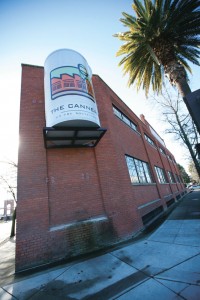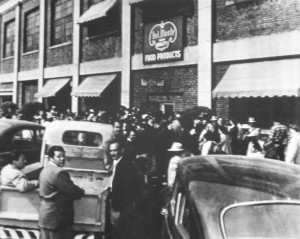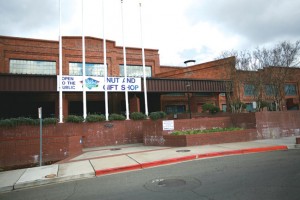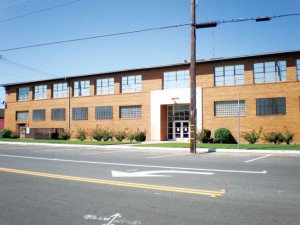The Big Tomato
Posted on March 11, 2011 – 5:37 AM | by AdminBy William Burg
During the first days of the Gold Rush, food was more likely to be shipped in from overseas than grown in California. Argonauts were more interested in mining than farming, and California was generally considered to be a vast desert. Sacramento was founded as a trade and transportation city on the way to the goldfields, not a farming town. As riches proved difficult to find by mining, some discouraged miners turned to farming (a profession some had abandoned in search of easy riches) and discovered the incredible fertility of the Central Valley’s soil. California’s real gold, they soon discovered, was in its agriculture. Sacramento was a city with a workforce, river transportation, and even a railroad—an ideal location for industries that turned the valley’s bounty into marketable products, like breweries, grain mills and canneries.
However, the same river that carried riverboats and freight also carried destructive floods that imperiled the young city and devastated farms in the unprotected flood plain. By the early 1900s, many of the same laborers who built the Central Pacific Railroad (primarily Chinese immigrants) constructed extensive levees to push back the flood waters. This allowed the rich Delta soil to bear amazing quantities of fruits and vegetables. To bring these products to market, Valley and Delta farmers turned to Sacramento, the region’s industrial and transportation hub. By the 1920s, we had the two largest canneries in the world (Cal-Pack #11 and Libby McNeill & Libby), the biggest of about 20 canning and packing plants in the city. Subsidiary industries produced tin cans and lug boxes for local canneries, and the demand for labor drew waves of immigrants to Sacramento. Thanks to union representation, cannery jobs paid better than rural field labor, which allowed cannery workers to purchase homes and start families in Sacramento. During this era, the conventional wisdom was that nearly every Sacramentan worked for either a railroad or a cannery, or fed someone who did.
Sacramento’s canning industry canned every imaginable farm product, but tomatoes were the best-known, earning Sacramento the nickname “The Big Tomato.” The city’s role as a center of industry, where beer, tomato sauce and even steam locomotives were made, is often forgotten, but the handful of surviving Sacramento cannery buildings serve as powerful reminders of the era.
Libby, McNeill & Libby Cannery
Arthur A. and Charles P. Libby, and their partner Archibald McNeill, formed their first partnership in Chicago in 1868, packing canned meats. Like Sacramento, Chicago’s stockyards, grain exchanges and lumber mills transformed the agricultural raw materials of the Midwest into finished commodities, using their own network of rivers and railroads. In 1912, Libby McNeill & Libby expanded their operation to Sacramento, investing $1,000,000 to build a nine-acre cannery complex at 31st Street, R Street and Stockton Boulevard. Served by two railroads (Southern Pacific and Sacramento Northern) and a wagon road, the Libby plant employed as many as 1000 workers in peak canning season. Fruit and vegetables generally arrived from area farms by wagon or truck, and canned goods left the plant in railroad boxcars. Today the Libby cannery is an office park, one of Sacramento’s earliest examples of adaptive reuse of industrial buildings, and is listed on the National Register of Historic Places.
Del Monte/California Packing Company
California Packing Company was incorporated as a combination of five West Coast canning companies, based in San Francisco. They are best known for the “Del Monte” brand of canned fruits and vegetables. They owned four Sacramento canneries, located at Front and P Street, Third and X Street, 19th and R Street, and 17th and C Street. Like the Libby cannery, they were served by two railroads each, and were adjacent to roads or riverfront docks leading to farming regions. Today, only Plant 11, located at 17th and C Street, completed in 1925, still stands. At its peak, Plant 11 alone employed 2500 workers, mostly women. The building is part of the Blue Diamond almond plant and continues its traditional use. It is also listed on the National Register.
Bercut-Richards Cannery
In 1931, Tom Richards and brothers Peter and Henry Bercut purchased a cannery constructed just south of the American River on North 7th Street in 1928 (the original owners had quickly gone out of business.) Producing their own “Sacramento” brand, Bercut-Richards became the single largest producer of tomato products in the region. In addition to tomatoes, they canned peaches grown on a 30 acre orchard next to the cannery.
In 1942, Sacramento’s Army Signal Corps depot moved from the state fairgrounds on Stockton and Broadway to the Bercut-Richards cannery complex. The cannery’s warehouses and rail access made it an excellent location for this supply function, and also continued canning during the war. By 1945, 1800 people worked at the Signal Depot facility. The site also became a camp for 554 German prisoners of war, who worked in the depot’s warehouses. After war’s end, the Signal Depot relocated to Fruitridge Road and the cannery resumed full-time canning operation.
The cannery was demolished in 2009-2010 to make way for the forthcoming “Township 9” development project. The only remnant of the Bercut-Richards cannery are the names of Richards Boulevard and Bercut Drive, and a small scalehouse that will be relocated to Richards Boulevard to serve as a passenger shelter for the new Regional Transit “Green Line” light rail line. Passengers will board trains where Southern Pacific boxcars were once packed with carloads of “Sacramento” brand
tomato juice.
Campbell’s Soup
Opened on Franklin Boulevard in 1947, this cannery was the third factory opened by the Campbell’s Soup Company and the last major cannery opened in Sacramento. Although they are still in operation, recent upgrades to their air filtration system means that South Sacramento no longer smells like Campbell’s tomato soup during peak canning season. California agriculture is still a massive industry, producing $36 billion in 2010 alone (by comparison, all the gold extracted from California from 1848 to the present day is worth about $25 billion.)







7 Responses to “The Big Tomato”
By Tim on Mar 15, 2011 | Reply
Great article. Glad to see someone appreciates Sacramento for its roots.
By S. Lyle Mar on Mar 18, 2011 | Reply
I have fond and not-so-fond memories of working the graveyard shift at Sierra Fruit Company’s cannery at 7th Street and Richards Blvd. I do miss being around all the conveyors and clanking machinery and making my rounds to monitor all the can cookers though!
By DAH on Mar 25, 2011 | Reply
Bill Burg, you never let me down. Thank You.
By Carol Robinson on Jul 9, 2013 | Reply
Great info! Thank you. Does anyone know the history of the big brick building that is on Alhambra and Folsom Blvds (south of Folsom Blvd.). Was it a cannery too?
By M. Boettger on Nov 10, 2013 | Reply
Very interesting. Friends of mine will move to Sacramento soon… Greetings to Sacramento, from Karlsruhe, Germany